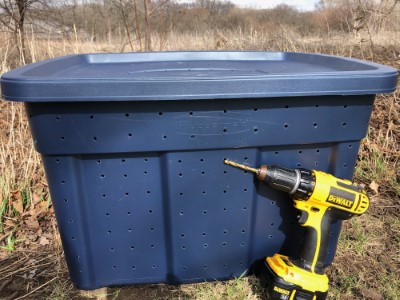Earth Science Week Classroom Activities
Sustaining Living Soil with Composting
Activity Source:
Soil Science Society of America. Adapted with permission.
Composting is the decomposition of organic waste materials in the presence of water, air, and microorganisms to produce organic fertilizer. Organic matter improves soil quality by feeding soil organisms, provides plants nutrients for growth, and enhances soil structure and water holding capacity., while reducing our dependence on synthetic fertilizers.
A key part of a healthy compost pile is a balance of green and brown organic matter. Greens are rich in nitrogen that help microorganisms grow. Browns are rich in carbon and provide food for soil microorganisms. In this activity, you will learn how to construct a simple compost bin, creating the right environment for microbial decomposition, to make a natural fertilizer that your soil will love.
Materials
- Plastic storage bin with lid (the darker the color the better, 25 gallon)
- Drill (3/16” bit recommended)
- “Greens”: fresh vegetable/fruit scraps (no meat or dairy) or fresh grass clippings
- “Browns”: dried leaves or grass, pine needles, straw, sawdust, or dryer lint
- Soil (topsoil, not potting soil)
- Shredded newspaper
- Small shovel or spading fork
- Spray bottle with water
- Soil temperature thermometer (optional)
- Another plastic bin with lid (optional)

A prepared compost bin.
Credit: Soil Science Society of America
Procedure
-
Carefully drill holes on all four sides and the top of the plastic bin to allow air to circulate. Drill 10 holes in the bottom to allow for water to drain.
-
Fill the container about 1/4 of the way with shredded newspaper, then add a soil layer (up to halfway).
-
Add a layer of browns on top of the soil, then a layer of greens, topping with another layer of browns.
-
Spray the mixture with water so that it is damp but not soaking wet. Replace the lid.
-
Each time greens are added, add browns on top, spray with water, then shake the bin to aerate the compost mixture. Tip and rock the bin from side to side then front to back.
-
Shake the compost bin or stir with a small shovel or spading fork every five days to aerate to container. Also, check that the compost is still moist and add water if necessary. The compost should be ready to use as an organic fertilizer in about two months.
-
Discuss: How does composting help reduce waste? What do microbes need to decompose waste? (Hint: Why is it important to turn compost piles?) How can adding compost help soil?
A supplemental activity using the compost bin and a thermometer to measure microbial activity with an accompanying datasheet is available at: www.soils4teachers.org/esw
NGSS Connections
- Science and Engineering Practices: Obtaining, Evaluating, and Communicating Information; Asking Questions and Defining Problems
- Disciplinary Core Ideas: Earth’s Materials and Systems
- Crosscutting Concepts: Systems and Systems Models; Influence of Science, Engineering, and Technology on Society and the Natural World
SDG Connections
- 2: Zero Hunger
- 12: Responsible Consumption and Production
- 15: Life on Land
